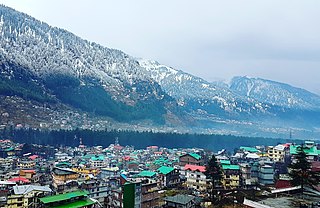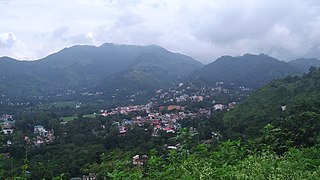
Kullu is a district in Himachal Pradesh, India. It borders Shimla district to the south, Mandi and Kangra districts to the west, Kinnaur to the east and the Lahaul and Spiti district to the north and east. The largest valley in this mountainous district is the Kullu Valley. The Kullu valley follows the course of the Beas River, and ranges from an elevation of 833 m above sea level at Aut to 3330 m above sea level at the Atal Tunnel South Portal, below the Rohtang Pass. The town of Kullu, located on the right side of the Beas River, serves as the administrative headquarters of the Kullu district. The Kullu district also incorporates several riverine tributary valleys of the Beas, including those of the Parvati, Sainj, and Tirthan rivers, and thus some regions somewhat distant from the Kullu valley. The economy of the district relies mainly on horticulture, agriculture, tourism, and traditional handicrafts.

Mandi district is one of the central districts of Himachal Pradesh state in northern India. The town of Mandi is the headquarters of the district.

Manali is a town, near Kullu town in Kullu district in the Indian state of Himachal Pradesh. It is situated in the northern end of the Kullu Valley, formed by the Beas River. The town is located in the Kullu district, approximately 270 kilometres (170 mi) north of the state capital of Shimla and 544 kilometres (338 mi) northeast of the national capital of New Delhi. With a population of 8,096 people recorded in the 2011 Indian census Manali is the beginning of an ancient trade route through Lahaul (H.P) and Ladakh, over the Karakoram Pass and onto Yarkand and Hotan in the Tarim Basin of China. Manali is a popular tourist destination in India and serves as the gateway to the Lahaul and Spiti district as well as the city of Leh in Ladakh.

Kullu is a municipal council town that serves as the administrative headquarters of the Kullu district of the Indian state of Himachal Pradesh. It is located on the banks of the Beas River in the Kullu Valley about 10 kilometres (6.2 mi) north of the airport at Bhuntar, Kullu.

Shimla district is one of the twelve districts of the state of Himachal Pradesh in northern India. Its headquarters is the state capital of Shimla. Neighbouring districts are Mandi and Kullu in the north, Kinnaur in the east, Uttarakhand in the southeast, Solan to the southwest and Sirmaur in the south. The elevation of the district ranges from 987 metres (3,238 ft) to 4,500 metres (14,764 ft).

Sundar Nagar is a town and a municipal council in Mandi district in the Indian state of Himachal Pradesh. It was formerly a princely state, known as Suket.

The black-throated bushtit, also known as the black-throated tit, is a very small passerine bird in the family Aegithalidae.

The dark-breasted rosefinch is a species of true finch in the monotypic genus Procarduelis. It is found in Bhutan, China, India, Laos, Myanmar, Nepal, Pakistan, Thailand, and Vietnam. Its natural habitats are boreal forests and subtropical or tropical high-altitude shrubland.

The pink-browed rosefinch is a finch in the family Fringillidae. The species was first described by Nicholas Aylward Vigors in 1831. It ranges across the northern regions of the Indian subcontinent, mainly in the Himalayas, and is migratory. It is found in Bhutan, Tibet, India, Nepal, and Pakistan. Its natural habitats are boreal forests and subtropical or tropical dry forests.

The streaked laughingthrush is a species of bird in the family Leiothrichidae. It is commonly found in the northern regions of the Indian subcontinent and some adjoining areas, ranging across Afghanistan, Bhutan, India, Nepal, Pakistan, Russia, and Tajikistan.

The variegated laughingthrush is a species of bird in the family Leiothrichidae. It is endemic to the northern regions of the Indian subcontinent, primarily the low-to-mid altitudes of the Himalayas. It ranges across Bhutan, India, Nepal and Tibet.

The black-crested tit, also known as the spot-winged tit, is a bird in the family Paridae. It was formerly considered a species, but is now widely considered a subspecies of the coal tit.

The long-tailed minivet is a species of bird in the family Campephagidae. It is found in southern and south-eastern Asia where it occurs in Afghanistan, Bangladesh, Bhutan, China, India, Laos, Myanmar, Nepal, Pakistan, Thailand, and Vietnam. Its natural habitats are subtropical or tropical moist lowland forest and subtropical or tropical moist montane forest.

The blue-fronted redstart is a species of bird in the family Muscicapidae, the Old World flycatchers. It breeds in central China and the Himalayas. Its natural habitat is temperate forests. The female is brownish-grey, with paler underparts.

The scaly-breasted cupwing or scaly-breasted wren-babbler is a species of bird in the Pnoepyga wren-babblers family, Pnoepygidae. It is found in southern and eastern Asia from the Himalayas to Indochina.

The grey bush chat is a species of passerine bird in the family Muscicapidae. It is found in the Himalayas, southern China, Taiwan, Nepal and mainland Southeast Asia.

The golden bush robin or golden bush-robin was first discovered in 1845 by Brian Houghton Hodgson, a British naturalist.

The Himalayan woodpecker is a species of bird in the family Picidae. It is found in the northern regions of the Indian subcontinent, primarily the Himalayas and some adjoining areas, and ranges across Afghanistan, India, Nepal, Bhutan and Pakistan. Its natural habitats are boreal forests and temperate forests. The International Union for Conservation of Nature has assessed its conservation status as being of "least concern".

The Sar Pass is in Parvati Valley of Kullu district of Himachal Pradesh, a state of India.

National Highway 3, or NH 3, is a national highway in India. It starts from Atari adjacent to India-Pakistan border and near Amritsar and terminates at Leh in Ladakh, via Manali in Himachal Pradesh.


























